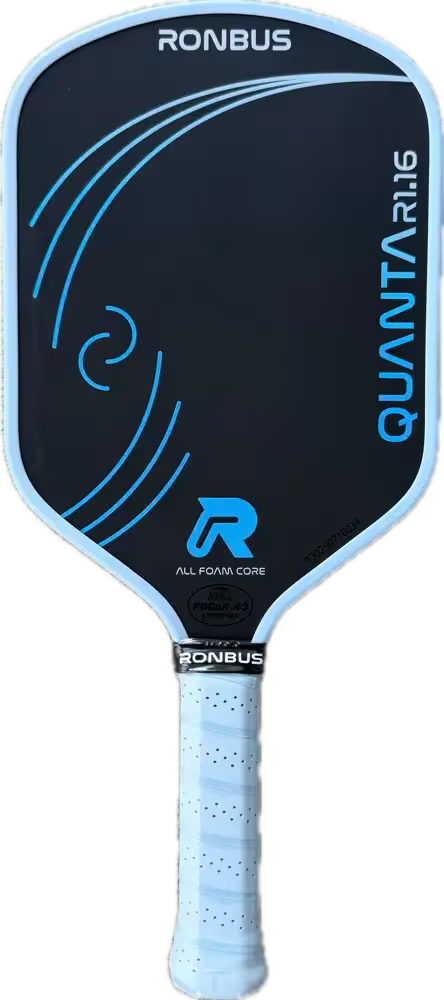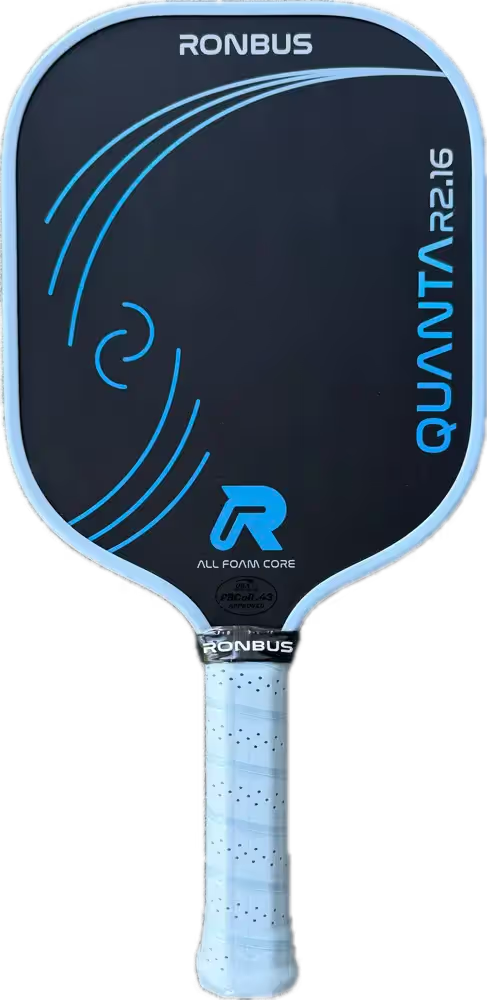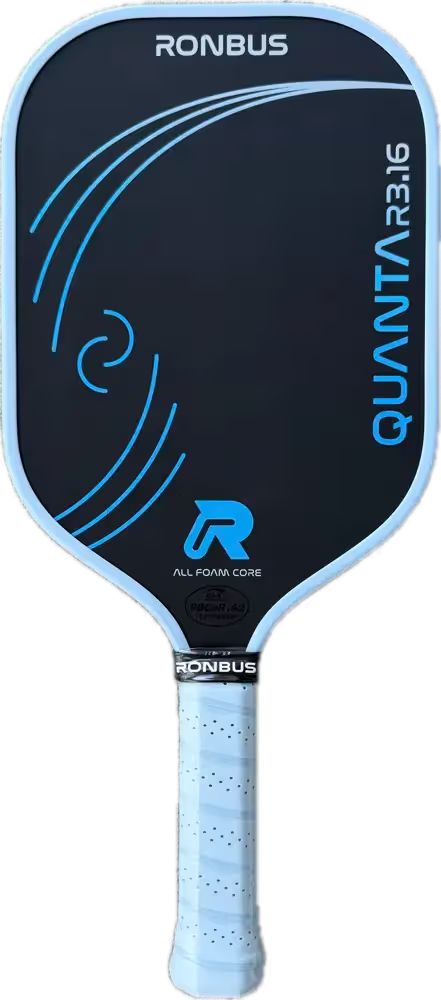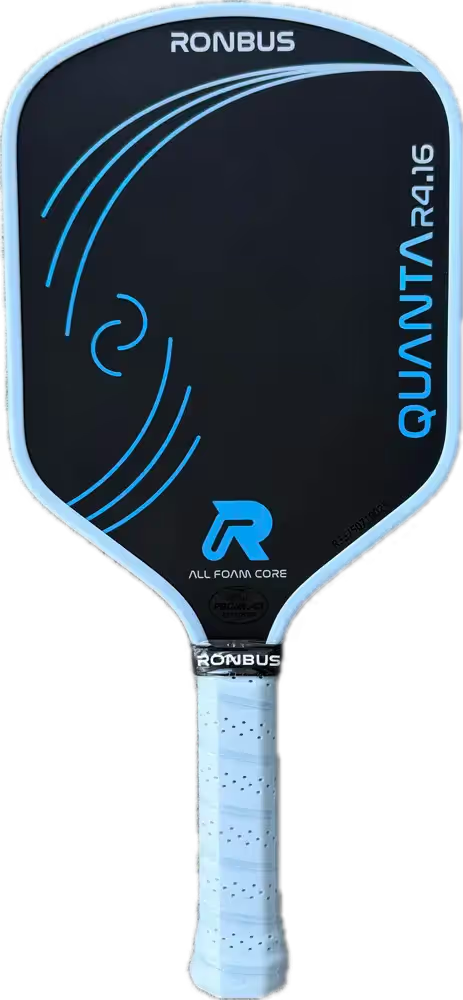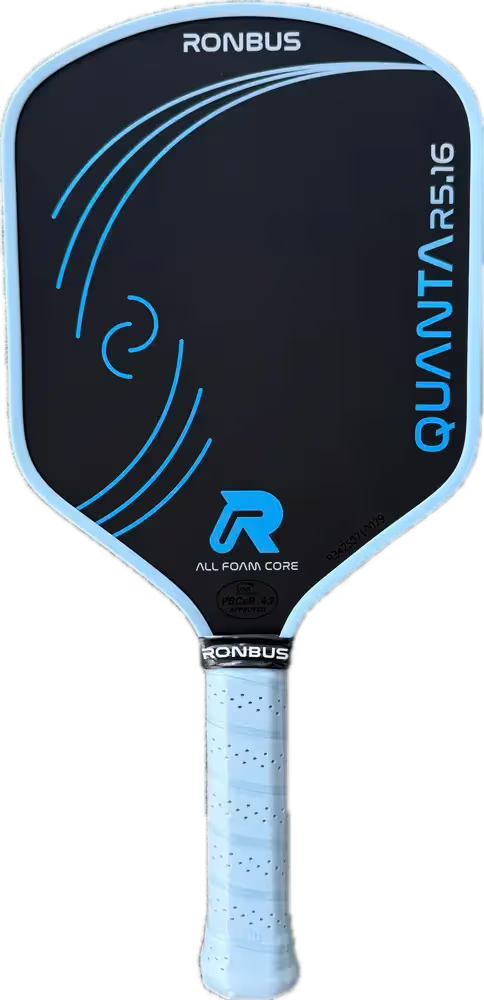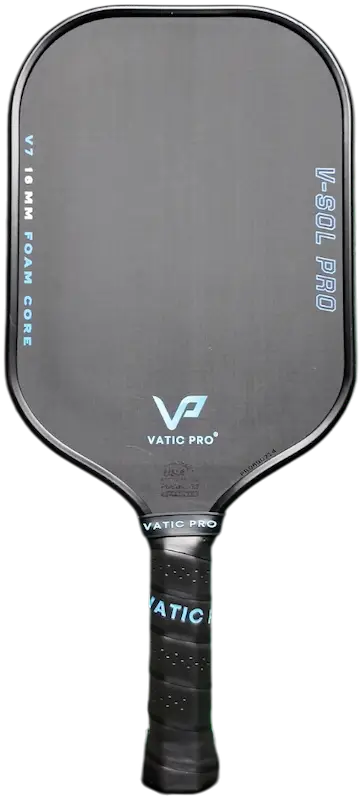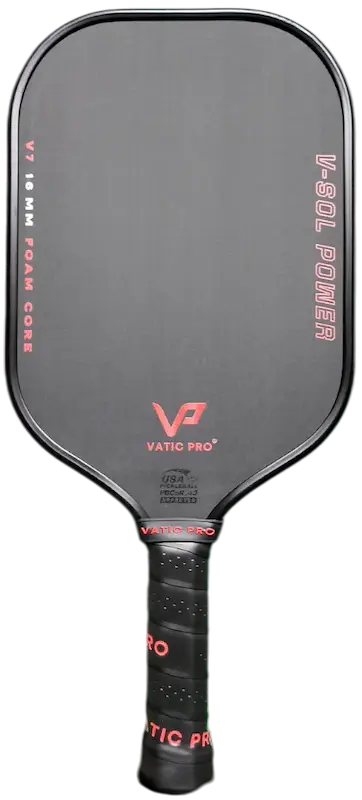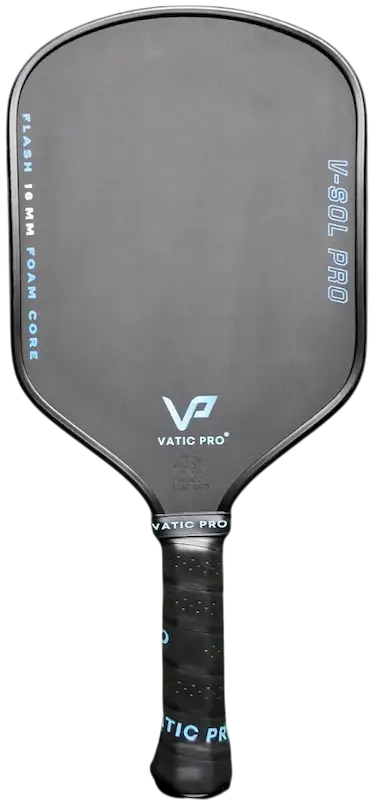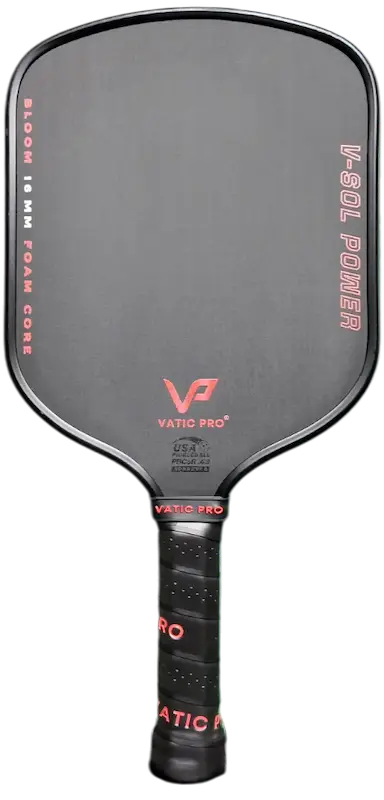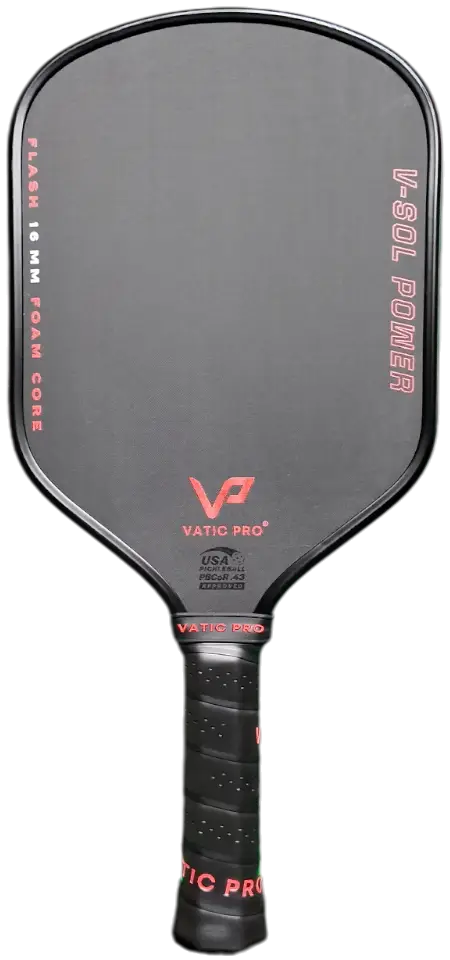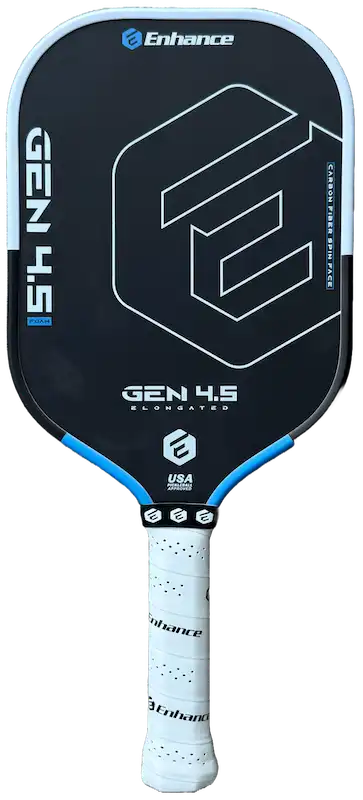TL;DR
- Both J6 models use 16.5" x 7.5" elongated shape with modified corners for 6.7 twist weight—significantly higher than the 6.18 average for elongated paddles
- J6NF delivers 59.4 mph serves (89th percentile) and 87 firepower score with stiffer carbon-fiberglass-carbon face construction
- J6FC+ produces 59.0 mph serves (84th percentile) and 83 firepower score with all-carbon face that provides more dwell time and ball pocketing
- Both hit 2,288-2,291 RPM spin (84th-85th percentile) and 38.1-38.2 mph punch volleys with coarse peel-ply texture
- $195 retail—use code MPB for 10% off at 808pickle.com
Intro
Honolulu Pickleball's J6 series introduces two elongated paddles that address a persistent problem with the shape category: instability on off-center hits. The J6NF and J6FC+ share identical 16.5 by 7.5-inch dimensions and a modified elongated profile, but diverge in face construction. The NF sandwiches fiberglass between carbon fiber layers for immediate pop and faster ball exit, while the FC+ uses multiple carbon fiber layers for a plusher response with more dwell time. Both deliver serve speeds in the 84th to 89th percentile, spin production in the 84th to 85th percentile, and punch volley speeds in the low-to-mid 80s percentile range.
Full disclosure: Honolulu sent these paddles with nothing expected in return. No money changed hands, and they didn't request a positive review. I do have a discount code—MPB—that saves 10% on purchases at 808pickle.com. Using it earns me a small commission that supports continued testing and content production.
The distinguishing characteristic here isn't revolutionary engineering. It's the 6.7 twist weight—substantially higher than the 6.18 average for elongated paddles in my database. That difference translates to less paddle rotation on mishits and more predictable performance during scrambles. The question becomes which face construction suits your game: the stiffer, more aggressive NF or the plusher, more controlled FC+.
Tech Overview
The J6 series uses a modified elongated shape that deviates from traditional designs like the Joola Perseus. Honolulu trimmed the upper corners and squared off the bottom face to redistribute weight. Removing material from the top reduces swing weight, while adding it to the bottom corners increases twist weight for improved stability. The result is a paddle that resists twisting more effectively than most elongated options without sacrificing face area or reach.
Both models use EPP foam in the center with an EVA foam perimeter ring. EPP is firmer than standard foam cores, providing more immediate energy return, while the softer EVA perimeter absorbs shock and dampens vibration. The J6NF connects these materials through a puzzle-piece interface where the EPP center interlocks with the EVA perimeter through notched connections. The J6FC+ takes a simpler approach with a continuous interface where the EPP center meets the EVA perimeter like a diving board.
The face construction creates the primary performance difference. The J6NF layers carbon fiber, fiberglass, and carbon fiber again—a CFC layup that adds stiffness and creates more immediate ball exit. The fiberglass layer functions as a structural reinforcement that increases face rigidity. The J6FC+ uses multiple layers of carbon fiber only, which creates a plusher feel with more dwell time. In the J2 series (Honolulu's hybrid shape), I gravitated toward the NF construction, but in this elongated format, the FC+ delivers more control and shot-shaping capability that makes it the more versatile option.
Both paddles are thermocompression formed with coarse peel-ply texture for spin generation. The design intent focuses on predictable, linear power delivery rather than explosive rebound. There's nothing unpredictable about how these paddles respond to input—the power scales consistently with swing speed, and the ball trajectory follows expected paths based on contact point and paddle angle.
Specs
The measured data shows two paddles that perform nearly identically despite different internal construction. Both models hit 8.14 ounces static weight, 118.15 to 118.3 swing weight, and 6.7 twist weight. That twist weight figure matters more than it might appear—the average elongated paddle in my database sits at 6.18, and lower twist weight correlates directly with increased paddle rotation on off-center hits. The higher number here means less paddle twisting when you miss the center, which translates to more forgiving performance during fast exchanges.
Serve speed separates them slightly. The J6NF edges ahead at 59.4 mph for 89th percentile performance, while the J6FC+ delivers 59.0 mph for 84th percentile. Both represent solid firepower for elongated paddles, though neither reaches the explosive territory of some competitors. Punch volley speeds cluster tightly at 38.2 mph for the NF and 38.1 mph for the FC+, landing both in the 81st to 84th percentile range for pop. That's strong but not exceptional—these paddles deliver controlled power rather than maximum acceleration.
Spin production shows minimal difference at 2,288 to 2,291 RPM, landing both in the 84th to 85th percentile range. Combined with the coarse peel-ply surface texture, these numbers translate to excellent bite on the ball. The firepower scores reflect the face construction differences—the J6NF scores 87 while the J6FC+ hits 83. That 4-point gap represents the immediate pop advantage from the fiberglass layer in the NF's face construction.
Handle dimensions are identical at 5.75 inches in length with a 4.125-inch circumference, providing more than enough room for two-handed backhands. The long handle contributes to the overall reach advantage that defines the elongated category.
What makes these specs notable is the combination of power and stability. Both models produce competitive serve speeds and spin numbers while maintaining higher twist weight than most elongated paddles. That combination addresses one of the category's persistent weaknesses without sacrificing the reach and leverage that make elongated paddles appealing.
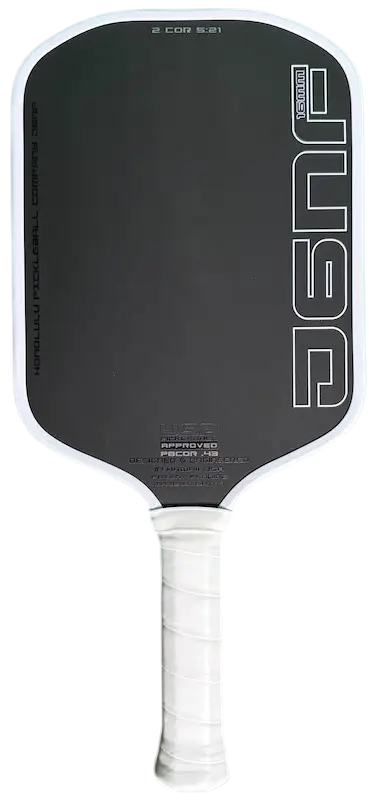
- Control
Best for strategic players who favor precision and placement over power, excelling in slow play and careful ball manipulation. - All-Court
Designed for versatile players who want the best of both worlds. These paddles balance control, power, and speed, adaptable to various playing styles. - Power
Ideal for aggressive players (aka, "bangers") who prioritize fast, powerful gameplay, sacrificing some control and sweet spot size for maximum force.
.webp)
- Control
Best for strategic players who favor precision and placement over power, excelling in slow play and careful ball manipulation. - All-Court
Designed for versatile players who want the best of both worlds. These paddles balance control, power, and speed, adaptable to various playing styles. - Power
Ideal for aggressive players (aka, "bangers") who prioritize fast, powerful gameplay, sacrificing some control and sweet spot size for maximum force.


Honolulu Pickleball Co.
J6NF 16mm
Power
$
195
808pickle.com
6-Months
.webp)
Honolulu Pickleball Co.
J6FC+ 16mm
Power
$
195
808pickle.com
6-Months
...
Playtest
The most noticeable characteristic in play is how stably both models perform compared to typical elongated paddles. That 6.7 twist weight shows up during scrambles and hand battles—off-center hits don't twist the paddle as much as they do on other elongated options. This becomes most apparent during fast exchanges at the kitchen line where precise paddle positioning matters less than with lower twist weight models.
Serve performance highlights the construction differences. The J6NF delivers more immediate pace with that fiberglass-stiffened face. Contact feels crisper, and ball exit happens faster. You get maximum speed with minimal swing effort, but the tradeoff is less ability to shape serve placement. The J6FC+ provides more controlled power—slightly slower but easier to guide into corners or target specific depths. The additional dwell time gives you more feedback at contact and more time to adjust trajectory.
Drive shots reveal each paddle's personality. The J6NF wants you to accelerate through contact for maximum pace. The stiffer face rewards aggressive swings but can feel harsh on mishits or when you're forced to defend. The J6FC+ gives you more time to shape shots with its plusher response. It's more forgiving when you're stretched or off-balance, and the added dwell time makes it easier to redirect pace rather than just absorbing it.
Hand battles show where the stability improvements matter most. Both models hold their line better than typical elongated paddles when blocking or resetting incoming pace. The J6FC+ excels here—that extra dwell time makes it easier to absorb power and redirect the ball with intention rather than just getting the paddle in the way. The NF can feel more deflective during rapid exchanges, particularly when you're defending against aggressive drivers.
Touch shots benefit from predictable, linear response. Drops stay on target, and you can work angles consistently without worrying about unpredictable ball behavior. The J6FC+ has a slight edge for placement thanks to that plusher feel—you get more sensory feedback about where the ball contacted the face, which helps with fine adjustments during points. Dinks feel controlled with both models, though neither provides the exceptional touch of softer, control-oriented paddles.
I added 6 grams of weight on the first curve up the neck to increase plow-through on both models. This modification brought the specs to 8.55 ounces static weight, 119.7 swing weight, and 7.2 twist weight. The adjustment improved stability and power without making either paddle feel unwieldy. The additional head weight helped with punch volleys and blocking, particularly during defensive sequences.
Sound differs between models in a way that reflects their construction. The J6NF produces a sharper crack at contact—louder and more pronounced. The J6FC+ has a deeper, more muted response, though it's not silent by any means. Neither paddle qualifies as exceptionally quiet, but the FC+ generates less audible feedback than the NF.
Shape Comparisons
Both J6 models use the same modified elongated shape, so there's no shape variation to compare within this series. The 16.5 by 7.5-inch dimensions with trimmed upper corners create a sweet spot that sits slightly lower on the face than traditional elongated designs. This positioning makes the most stable contact zone more accessible during hand battles and resets where paddle positioning tends to be lower.
The squared-off bottom corners contribute to the improved twist weight by redistributing mass closer to the paddle's vertical axis. You feel this most noticeably on shots that contact near the edges—the paddle resists rotation better than designs with more extreme elongation or weight concentrated in the upper portion of the face.
Compared to traditional elongated shapes, the J6 profile offers better stability without sacrificing meaningful face area. The tradeoff is slightly less reach at the very top of the paddle, but that rarely matters in practical play. The lower sweet spot positioning and improved edge stability provide more consistent benefits than the marginal reach advantage of more extreme elongated designs.
For players transitioning from standard or hybrid shapes, the J6 profile provides less of an adjustment than traditional elongated paddles. The modified corners make the paddle feel less blade-like, and the improved twist weight reduces the learning curve typically associated with elongated shapes. You still get the leverage and reach advantages that define the category, but the stability improvements make the paddles more accessible to players who haven't exclusively used elongated designs.
Recommendations
Choose the J6NF if you want aggressive power delivery with immediate ball exit. The carbon-fiberglass-carbon face provides a stiffer response that maximizes serve speed and drive pace. This paddle suits players who generate their own power through aggressive swings and who prioritize pace over placement. It's less forgiving on defensive shots and requires more precise timing, but it delivers maximum firepower when you catch it clean.
Select the J6FC+ if you want more controlled power with better shot-shaping capability. The all-carbon face creates more dwell time that makes ball placement easier and provides better feel for touch shots. This paddle excels at absorbing pace and redirecting it with intention rather than just deflecting incoming drives. It's the more versatile option for players who mix up their shot selection and who value consistency over peak power output.
Against the Selkirk Boomstick, the J6 series trades some raw firepower for lighter playability and more forgiving performance during scrambles. The Boomstick can play quite poppy and delivers higher peak power, but the J6 models provide more consistent response and better stability on off-center hits.
Compared to the Joola Pro 4 series, the differences are minor. The J6 models might have a slight edge on control for more predictable shot execution, though the differences aren't obvious in most playing situations. The Pro 4 series might deliver slight advantages in peak power, but the J6 series provides more consistent performance and will likely outlast the Pro 4's honeycomb cores from a durability standpoint.
The Bread & Butter LOCO and Quanta series from Ronbus offer similar power profiles but trade some J6 consistency for higher peak firepower. Whether one is more predictable or playable than the other becomes difficult to distinguish—foam core technology has reached a point where quality paddles in this category perform quite similarly. The differences come down to subtle feel preferences rather than obvious performance gaps.
Players who struggle with elongated paddle instability will appreciate what the J6 series delivers. The higher twist weight makes these more forgiving than most elongated options without requiring significant weight modifications to achieve playable stability. Players who exclusively use hybrid or standard shapes might find the transition easier with these models than with traditional elongated designs.
Price and Value
At $195 retail, the J6 series competes directly with premium elongated paddles from established brands. Use code MPB for 10% off at 808pickle.com, which brings the price down to approximately $175.50—a more competitive position relative to alternatives.
The construction quality justifies the price point. Thermocompression forming creates more consistent face response than cheaper manufacturing methods, and the dual-foam core design with EPP center and EVA perimeter represents thoughtful engineering rather than cost-cutting. The coarse peel-ply texture holds up well over extended use, and the overall build quality suggests these paddles will maintain performance characteristics longer than budget alternatives.
However, the elongated foam core category has become crowded with quality options. The Ronbus Quanta series, Bread & Butter LOCO series, Enhance Gen 4.5, and Vatic Pro V-Sols all compete in similar price ranges with comparable performance profiles. The J6 series doesn't dominate this field—it competes within it. The higher twist weight provides a legitimate advantage over some competitors, but whether that's worth the premium depends on how much you value stability over other characteristics.
For players specifically seeking elongated paddles with above-average twist weight and predictable power delivery, the J6 series represents solid value. For players simply exploring the elongated category without specific stability concerns, multiple alternatives merit consideration before committing to the J6 price point.
The 10% discount code improves the value proposition meaningfully. At $175.50, these paddles sit more comfortably among premium options without stretching into territory where performance advantages need to be more pronounced to justify the cost.
Conclusion
The Honolulu J6NF and J6FC+ address legitimate weaknesses in the elongated paddle category through higher twist weight and modified shape design. The NF delivers more immediate pop with its carbon-fiberglass-carbon construction, while the FC+ provides more dwell time and shot-shaping capability with its all-carbon face. Both produce competitive serve speeds in the 84th to 89th percentile, spin production in the 84th to 85th percentile, and punch volley speeds in the low-to-mid 80s percentile range while maintaining 6.7 twist weight—significantly higher than the 6.18 average for elongated paddles.
The FC+ emerges as the more versatile option for most players. The plusher feel and additional dwell time provide better control during defensive sequences and more precise shot placement without sacrificing meaningful power. The NF suits players who prioritize maximum serve speed and drive pace over shot-shaping capability, but the stiffer face can feel harsh on mishits.
For players who've struggled with less stable elongated paddles or who want to explore the shape without needing to add significant weight modifications, the J6 series delivers on its core value proposition. The paddles perform predictably, maintain competitive power and spin numbers, and provide above-average forgiveness for the elongated category.
Purchase directly at 808pickle.com using code MPB for 10% off. Questions about specific performance characteristics or how these compare to other paddles you're considering? Leave them in the comments below.
Discount Code
Similar Paddles


%20(1100%20x%20220%20px)%20(1000%20x%20300%20px)%20(1).webp)











